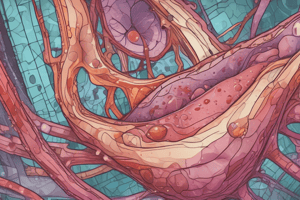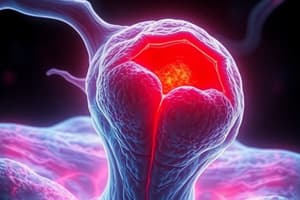Podcast
Questions and Answers
What is the primary mechanism of tissue repair by regeneration?
What is the primary mechanism of tissue repair by regeneration?
- Proliferation of residual uninjured cells and maturation of tissue stem cells (correct)
- Fibrosis through extensive collagen deposition
- Deposition of connective tissue
- Cell death by apoptosis
What is the term used to describe the extensive deposition of collagen in organs such as the lungs, liver, and kidney?
What is the term used to describe the extensive deposition of collagen in organs such as the lungs, liver, and kidney?
- Scar formation
- Regeneration
- Fibrosis (correct)
- Cell proliferation
What is the role of stellate cells in liver tissue?
What is the role of stellate cells in liver tissue?
- Initiating DNA replication
- Regulating cell proliferation
- Producing growth factors
- Major collagen producers (correct)
What is a critical factor in cell proliferation during tissue regeneration?
What is a critical factor in cell proliferation during tissue regeneration?
What is the term used to describe the development of mature cells from stem cells?
What is the term used to describe the development of mature cells from stem cells?
What is the phase of the cell cycle where cells are not actively cycling?
What is the phase of the cell cycle where cells are not actively cycling?
What is the purpose of the G1 restriction point in the cell cycle?
What is the purpose of the G1 restriction point in the cell cycle?
What type of cyclin binds to CDKs at the end of G1 and commits the cell to DNA replication?
What type of cyclin binds to CDKs at the end of G1 and commits the cell to DNA replication?
What is the primary mechanism of tissue repair by scar formation?
What is the primary mechanism of tissue repair by scar formation?
What is the term used to describe the regulation of cell populations by altering stem cell input, cell death, or rates of proliferation or differentiation?
What is the term used to describe the regulation of cell populations by altering stem cell input, cell death, or rates of proliferation or differentiation?
Which of the following is NOT a type of adhesive glycoprotein?
Which of the following is NOT a type of adhesive glycoprotein?
What is the primary mechanism of repair in healing by first intention?
What is the primary mechanism of repair in healing by first intention?
What type of tissue is unique to healing wounds?
What type of tissue is unique to healing wounds?
What is the primary function of the G1/S checkpoint in the cell cycle?
What is the primary function of the G1/S checkpoint in the cell cycle?
What type of tissues are continuously dividing and replaced by maturation from stem cells and by proliferation of mature cells?
What type of tissues are continuously dividing and replaced by maturation from stem cells and by proliferation of mature cells?
What is the process by which connective tissue is reorganized to produce a stable fibrous scar?
What is the process by which connective tissue is reorganized to produce a stable fibrous scar?
What is the primary function of growth factors?
What is the primary function of growth factors?
What is the type of wound healing that involves minimal scarring and primarily involves epithelial regeneration?
What is the type of wound healing that involves minimal scarring and primarily involves epithelial regeneration?
What is the term for the combination of proliferating fibroblasts, loose connective tissue, new blood vessels, and scattered chronic inflammatory cells?
What is the term for the combination of proliferating fibroblasts, loose connective tissue, new blood vessels, and scattered chronic inflammatory cells?
What is the main component of the extracellular matrix?
What is the main component of the extracellular matrix?
What is the type of wound healing that involves a combination of regeneration and scarring?
What is the type of wound healing that involves a combination of regeneration and scarring?
What is the primary function of the M/G1 checkpoint?
What is the primary function of the M/G1 checkpoint?
What is the term for the reorganization of connective tissue to produce a stable fibrous scar?
What is the term for the reorganization of connective tissue to produce a stable fibrous scar?
What is the primary function of the G2/M checkpoint?
What is the primary function of the G2/M checkpoint?
What is the primary function of the extracellular matrix in tissue repair?
What is the primary function of the extracellular matrix in tissue repair?
What is the type of protein that includes fibronectin and laminin?
What is the type of protein that includes fibronectin and laminin?
What is the term for the process by which damaged tissue is replaced with connective tissue?
What is the term for the process by which damaged tissue is replaced with connective tissue?
What is the primary function of stem cells?
What is the primary function of stem cells?
What is the primary function of growth factor receptors?
What is the primary function of growth factor receptors?
What type of collagen is associated with the basement membrane?
What type of collagen is associated with the basement membrane?
What occurs during the second week of healing by first intention?
What occurs during the second week of healing by first intention?
What is a characteristic of healing by second intention?
What is a characteristic of healing by second intention?
What type of ulcers can be caused by poor blood flow?
What type of ulcers can be caused by poor blood flow?
What is a consequence of exaggerated wound contraction?
What is a consequence of exaggerated wound contraction?
At what stage is the scar tissue largely devoid of inflammatory cells?
At what stage is the scar tissue largely devoid of inflammatory cells?
What is the term for the formation of new blood vessels?
What is the term for the formation of new blood vessels?
What is the result of wound contraction mediated by myofibroblasts?
What is the result of wound contraction mediated by myofibroblasts?
What type of wounds exhibit impaired healing?
What type of wounds exhibit impaired healing?
What is the characteristic of the scar tissue at the end of the first month?
What is the characteristic of the scar tissue at the end of the first month?
What is the outcome of exaggerated wound contraction in burn patients?
What is the outcome of exaggerated wound contraction in burn patients?
Flashcards are hidden until you start studying
Study Notes
Tissue Repair and Regeneration
- There are two types of tissue repair: regeneration and scar formation.
- Regeneration occurs through the proliferation of residual uninjured cells and maturation of tissue stem cells.
- Scar formation occurs through the deposition of connective tissue.
Scar Formation
- Fibrosis is the extensive deposition of collagen that occurs in response to chronic inflammation or ischemic necrosis.
- Stellate cells are the major collagen producers in the liver.
Cell and Tissue Regeneration
- Regeneration involves cell proliferation, which is driven by growth factors and the development of mature cells from stem cells.
- Cell numbers can be altered by increased or decreased rates of stem cell input, cell death, or changes in the rates of proliferation or differentiation.
Cell Cycle
- The cell cycle consists of four phases: G1 (presynthetic growth), S (DNA synthesis), G2 (premitotic growth), and M (mitosis).
- Quiescent cells are in the G0 state.
- The cell cycle has checkpoints, including the G1/S checkpoint, G2/M checkpoint, and M/G1 checkpoint, which ensure the integrity of DNA and prevent DNA damage.
Cyclins
- There are four classes of cyclins: G1/S cyclins, S cyclins, M cyclins, and G1 cyclins.
- Each class of cyclins binds to CDKs at specific phases of the cell cycle to promote cell proliferation.
Proliferative Capacities of Tissues
- Tissues are divided into three groups based on their proliferative capacity: labile, stable, and permanent tissues.
- Labile tissues are continuously dividing and replacing cells, such as the small and large bowel, skin, and bone marrow.
- Stable tissues are comprised of quiescent cells that can reenter the cell cycle to regenerate tissue when necessary, such as the liver.
- Permanent tissues are terminally differentiated and nonproliferative in postnatal life, such as most neurons and cardiac muscle cells.
Stem Cells
- There are two kinds of stem cells: embryonic stem cells and adult stem cells.
- Embryonic stem cells are derived from embryos and are totipotent, meaning they can become any cell type.
- Adult stem cells are derived from adult tissue and give rise to a restricted range of cells.
Growth Factors
- Growth factors are proteins that stimulate the survival and proliferation of particular cells.
- They are produced by most cell types and influence cell movement, contractility, and differentiation.
- Growth factors are grouped into families according to their structure, and the major growth factors include EGF, TGF-beta, FGF, VEGF, and PDGF.
Signaling Mechanisms of Growth Factor Receptors
- Signaling can occur through autocrine, paracrine, or endocrine mechanisms.
Extracellular Matrix (ECM)
- ECM is a complex of proteins that assembles into a network surrounding cells and constitutes a significant proportion of any tissue.
- ECM is composed of fibers, including collagen and elastin, and is made up of cells called fibroblasts.
- ECM is critical for development, healing, and maintaining normal tissue.
- ECM has several functions, including sequestering water, providing mechanical support, controlling cell proliferation, and serving as a reservoir for growth factors.
Role of ECM in Tissue Repair
- ECM occurs in two basic forms: interstitial matrix and basement membrane.
- Interstitial matrix is composed of fibrillar and nonfibrillar collagens, fibronectin, elastin, proteoglycans, and hyaluronate.
- Basement membrane is composed of amorphous nonfibrillar type IV collagen and laminin.
Wound Healing
- Wound healing can occur through regeneration or scarring.
- Repair by scarring leads to the formation of a scar and is a combination of regeneration and scar formation.
- Granulation tissue is a type of tissue that forms during wound healing and is composed of proliferating fibroblasts, loose connective tissue, new blood vessels, and scattered chronic inflammatory cells.
Healing of Skin Wounds
- Healing of skin wounds can be classified into two types: healing by first intention (primary union) and healing by second intention (secondary union).
- Healing by first intention occurs when epithelial regeneration is the principal mechanism of repair, resulting in a small scar with minimal wound contraction.
- Healing by second intention is a complex repair process involving a combination of regeneration and scarring, resulting in a larger scar.
Studying That Suits You
Use AI to generate personalized quizzes and flashcards to suit your learning preferences.





